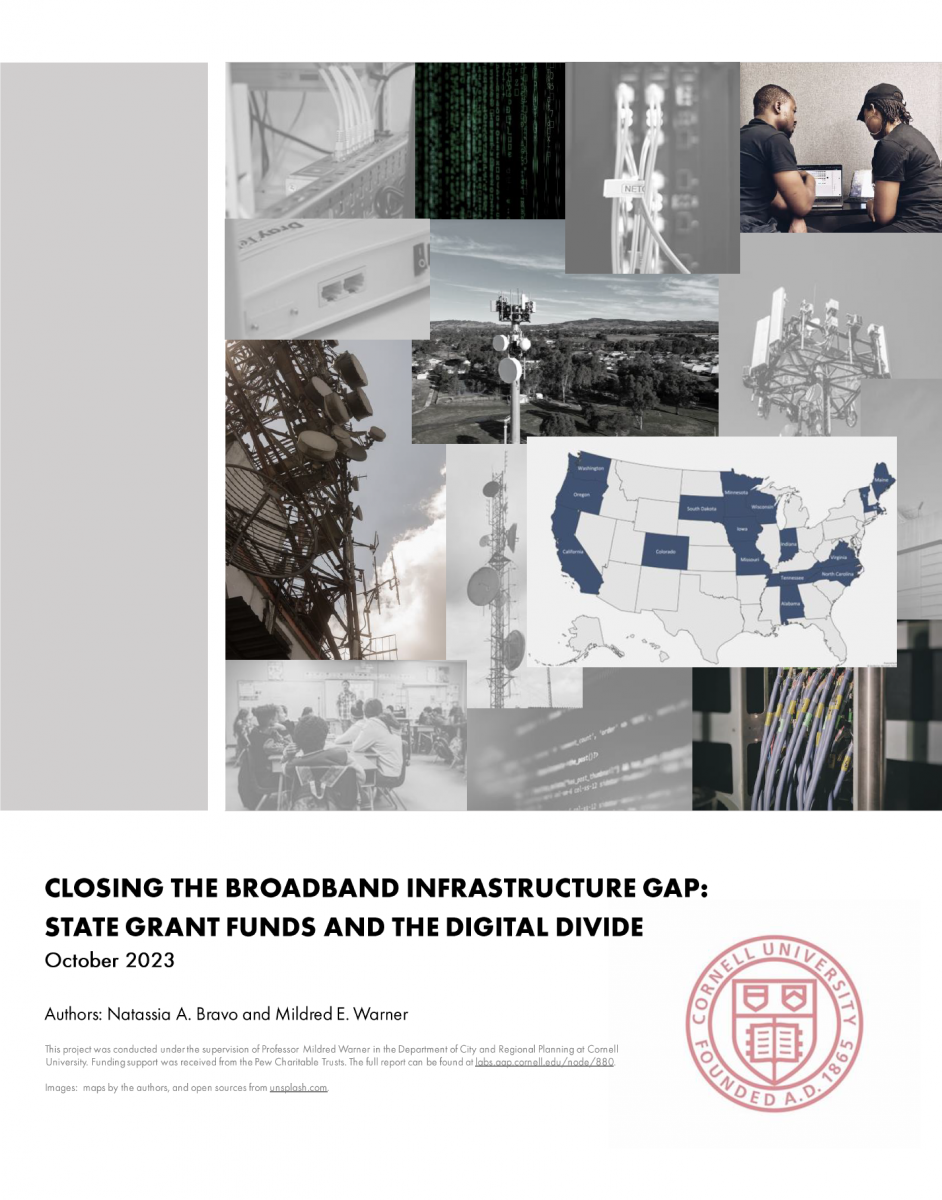Lessons From State Broadband Grants Before The Pandemic
Thursday, November 9, 2023
Digital Beat
Lessons From State Broadband Grants Before The Pandemic

Each year, TPRC and the Benton Institute for Broadband & Society recognize scholarship in the area of digital inclusion and broadband adoption with the Charles Benton Broadband & Society Prize. For 2023, the winning paper comes from Natassia Bravo, a Ph.D. Candidate, and Professor Mildred E. Warner both of Cornell University.
Despite increased reliance on access to high-capacity and reliable broadband Internet for everyday activities, disparities in fixed broadband availability persist. States’ broadband programs are part of the effort to close the infrastructure gap,[1] which has been linked to geographic, demographic, socio-economic, market, and policy factors.[2],[3] However, the pandemic is prompting a shift in broadband policy—with the concept of “access” being expanded to address both disparities in coverage and digital equity concerns.
Our report, “Closing the Broadband Infrastructure Gap: State Grant Funds and the Digital Divide,”[4] examines pre-pandemic data of state broadband grants in 17 states, collected by The Pew Charitable Trusts. While state broadband programs each have their own priorities and strategies when distributing funds, we explore the overall trends in how funds were distributed, and discuss the implications of our results for digital equity and states’ role in closing the digital divide. What can we learn from how states have allocated funds in the past years?
Methodology
Using data collected by The Pew Charitable Trusts on 724 state broadband grants awarded across 17 states, we looked at the characteristics of funded projects: provider and grantee type, technology type, metro/nonmetro status, and whether these projects included middle mile infrastructure and/or connected to a local planning process. To understand how state policy addressed the digital divide, we matched Pew’s broadband grant data with 1) county-level data on demographic, socioeconomic and market characteristics from American Community Survey and the Federal Communications Commission, and 2) state-level data on match requirements and municipal broadband restrictions from The Pew Charitable Trusts and Temple University, respectively. Key findings are outlined below.
Finding 1: In some respects, state broadband programs were ahead of the curve and raised the standards.
State programs in our study were flexible in terms of their technology and speeds eligibility requirements: Most were tech neutral, and their minimum speed thresholds equal to or below the FCC’s definition of broadband (10/1 or 25/3 Mbps download/upload speeds). However, while states did fund a diverse array of broadband technologies, more than half of grants (57%) supported fiber deployment. Fiber networks are costly to deploy, but provide fast, reliable and high-capacity service. This suggests that states are already in a position to meet the Broadband Equity, Access, and Deployment (BEAD) Program’s higher broadband speed thresholds. Areas without access to 25/3 Mbps are now defined as “unserved” and should qualify for BEAD funds. While BEAD encourages fiber deployment, state programs will need to maintain flexibility in terms of their eligibility requirements, as fiber might not be a one-size-fits-all solution for all unserved areas.
Finding 2: In other respects, states’ broadband programs were cautious and supported traditional actors.
While a majority of state grants (74%) supported providers operating in a single region, these were primarily traditional providers—for-profit private telephone companies, telephone cooperatives, and wireless Internet service providers. In contrast, non-traditional providers like electric cooperatives and municipal providers accounted for a small fraction of grants (8% and 3%, respectively). While the availability of non-traditional providers varies by state, municipal providers may face other barriers – such as state municipal broadband preemption,[5] challenges from private incumbents, or funding eligibility requirements that prioritize private providers and/or public-private partnerships. BEAD encourages state programs to consider competitive applications from non-traditional providers,[6] as they may be feasible alternatives for rural and remote communities where interest from private providers is lacking.
Finding 3: State broadband programs can use criteria to attract projects with added community benefits.
Using scoring criteria, state programs can give weight to projects that will not only provide last-mile coverage, but that also meet some of the program’s additional goals. For example, in our study, eleven state program gave weight to projects serving anchor institutions, which meant supporting the deployment of middle-mile infrastructure as well as last-mile infrastructure. In rural areas, high-capacity middle-mile infrastructure can support last-mile deployment[7] and provide service to libraries and schools, which often operate as alternative points of access for disadvantaged groups that lack home Internet service.[8] We found that 12% of funded projects included middle-mile infrastructure.
We also examined common characteristics and key differences between counties with and without funded projects, and between metro and nonmetro counties with funded projects. We were interested in the impact of county-level demographic, socioeconomic and market factors, as well as state-level policy factors, on the allocation of grants.
Finding 4: State broadband programs have traditionally focused on expanding coverage, but there is a need for policies that address additional concerns of digital equity.
Previous research has observed that rural, low-income, and minority individuals lag behind in terms of broadband access[9] and adoption.[10] In low-density areas, significant deployment costs can be a contributing factor to these disparities. Networks will need to expand across vast, sparsely populated areas to reach as many customers as possible.[11] State broadband grants can play a key role in offsetting the costs of deployment, and we learned that low-density metro and nonmetro counties received more grants and more funds overall. In addition, states also supported buildout in nonmetro counties with low adoption rates, which received more grants.
However, more efforts will be needed to reach communities less likely to be served. We learned that nonmetro counties with more grants had larger populations, more individuals with higher educational attainment, fewer minorities, and less poverty. This suggests a need for program policies that center not only on low population density, but the full range of demographic and socio-economic factors that have been linked to the digital divide—including rurality, race, poverty, and inequality.
Finding 5: State broadband programs may need to assess whether some policies could become barriers for communities with limited capacity and resources.
We included two state-level factors in our analysis: Match requirements and municipal broadband restrictions. Previous publications have raised concerns over the disproportionate impact of match requirements on rural and high-poverty areas.[12],[13] While match requirements varied widely across states in our study, fewer projects were funded in states with higher match requirements. Future research might focus on the relationship between local fiscal capacity and match percentages, particularly for rural, low-density, and high-poverty areas.
The effect of municipal broadband restrictions was more nuanced. In states that restricted municipal broadband, more projects in nonmetro counties were funded. Because these restrictions limit the number of provider choices, rural communities will likely rely on state grants to attract private providers.
Conclusion
 The digital divide is a multilayered issue linked to geographic, demographic, socio-economic, and market factors, and state broadband programs can play a key role in closing the broadband infrastructure gap. Our report explores how state broadband programs allocated grants in the years before the pandemic. We learned that state programs can be innovative: They were funding fiber deployment before federal policy made it a priority and supported buildout in low-density and low-adoption areas. However, our results also suggest a need for a broader approach to access and digital equity, that ensures state funds will reach communities that are more likely to be unserved and underserved.
The digital divide is a multilayered issue linked to geographic, demographic, socio-economic, and market factors, and state broadband programs can play a key role in closing the broadband infrastructure gap. Our report explores how state broadband programs allocated grants in the years before the pandemic. We learned that state programs can be innovative: They were funding fiber deployment before federal policy made it a priority and supported buildout in low-density and low-adoption areas. However, our results also suggest a need for a broader approach to access and digital equity, that ensures state funds will reach communities that are more likely to be unserved and underserved.
Acknowledgments
See the full report: https://labs.aap.cornell.edu/node/880. This work was supported by funding from The Pew Charitable Trusts.
Natassia Bravo is a Ph.D. Candidate at the Department of City and Regional Planning at Cornell University. Her research focuses on the role of local government and the impact of state regulation on rural broadband deployment in the US. Mildred E. Warner is a Professor in the Department of City and Regional Planning and the Department of Global Development at Cornell. They were awarded a grant from The Pew Charitable Trusts in 2022, and received the Charles Benton Broadband & Society Prize in September 2023 at TPRC51. Currently, they are researching case studies of innovative rural broadband projects that received state funding. For more information, see the Local Government Restructuring Lab’s website: https://labs.aap.cornell.edu/node/860
Notes and reference
[1] The Pew Charitable Trusts (2020) “How States Are Expanding Broadband Access”. https://www.pewtrusts.org/en/research-and-analysis/reports/2020/02/how-states-are-expanding-broadband-access
[2] Flamm, K. and Chaudhuri, A. (2007) An analysis of the determinants of broadband access. Telecommunications Policy, 31(6-7), 312-326. https://doi.org/10.1016/j.telpol.2007.05.006
[3] Whitacre, B. and Gallardo, R. (2020) State broadband policy: Impacts on availability. Telecommunications Policy, 44(9), 102025, 1-17. https://doi.org/10.1016/j.telpol.2020.102025
[4] Bravo, N. & Warner, M. (2023). “Closing the Broadband Infrastructure Gap: State Grant Funds and the Digital Divide.” Department of City and Regional Planning, Cornell University. https://labs.aap.cornell.edu/node/880
[5] Cooper, T. (2023) “Municipal Broadband 2023: 16 States Still Restrict Community Broadband”. BroadbandNow. Retrieved from: https://broadbandnow.com/report/municipal-broadband-roadblocks
[6] “Internet For All: Frequently Asked Questions and Answers Draft 2.0, Broadband Equity, Access and Deployment (BEAD) Program” (September 2022). Retrieved from the US Department of Commerce National Telecommunications and Information Administration website: https://broadbandusa.ntia.doc.gov/sites/default/files/2022-09/BEAD-Frequently-Asked-Questions-%28FAQs%29_Version-2.0.pdf
[7] Sallet, J. (2020) “Community Anchor Institutions as Launching Pads for High-Performance Broadband Deployment”. Benton Institute for Broadband & Society. Retrieved from: https://www.benton.org/blog/community-anchor-institutions-launching-pads-high-performance-broadband-deployment
[8] Turner Lee, N., Seddon, J., Tanner, B. and Lai, S. (2022) “Why the federal government needs to step up efforts to close the rural broadband divide”. Brookings. Retrieved from: https://www.brookings.edu/research/why-the-federal-government-needs-to-step-up-their-efforts-to-close-the-rural-broadband-divide/
[9] Zahnd, WE, Bell, N, Larson, AE (2022) Geographic, racial/ethnic, and socioeconomic inequities in broadband access. The Journal of Rural Health, 38(3), 519– 526. https://doi.org/10.1111/jrh.12635
[10] Whitacre, B., Strover, S. and Gallardo, R. (2015) “How much does broadband infrastructure matter? Decomposing the metro–non-metro adoption gap with the help of the National Broadband Map”. Government Information Quarterly 32, 261-269. http://dx.doi.org/10.1016/j.giq.2015.03.002
[11] Parsons, S. G. and Stegeman, J. (2021) “The Economics of Subsidies to Rural Networks: Implications for Broadband in the United States”. Southern California Interdisciplinary Law Journal, 30(3), 659-694. https://heinonline.org/HOL/Page?handle=hein.journals/scid30&div=28&g_sent=1&casa_token=&collection=journals
[12] “Breaking Down Barriers to Broadband Access” (August 11, 2022) US Government Accountability Office. Retrieved from: https://www.gao.gov/blog/breaking-down-barriers-broadband-access
[13] Smith, N. (2023) “High-Cost Areas, Match Waivers, and the Problem of Commercial Sustainability”. Connected Nation. https://connectednation.org/blog/2023/03/14/high-cost-areas-match-waivers-and-the-problem-of-commercial-sustainability/
The Benton Institute for Broadband & Society is a non-profit organization dedicated to ensuring that all people in the U.S. have access to competitive, High-Performance Broadband regardless of where they live or who they are. We believe communication policy - rooted in the values of access, equity, and diversity - has the power to deliver new opportunities and strengthen communities.
© Benton Institute for Broadband & Society 2023. Redistribution of this email publication - both internally and externally - is encouraged if it includes this copyright statement.
For subscribe/unsubscribe info, please email headlinesATbentonDOTorg






